第26届世界自杀预防大会
国家风情
北京是中华人民共和国首都,是世界闻名的历史古城、文化名城,具有丰富的旅游资源,对外开放的旅游景点达200多处,有世界上最大的皇宫紫禁城、祭天神庙天坛、皇家花园北海、皇家园林颐和园,还有八达岭、慕田峪、司马台长城以及世界上最大的四合院恭王府等各胜古迹。全市共有文物古迹7309项,其中国家文物保护单位42个,市级文物保护单位222个。北京的市树为国槐和侧柏,市花为月季和菊花。另外,北京出产的象牙雕刻、玉器雕刻、景泰蓝、地毯等传统手工艺品驰誉世界。
气候
北京属于大陆性季风气候,气候温和,四季分明。每年9月至次年4月,干寒的冬季风从西伯利亚和蒙古高原吹来,寒冷干燥。每年的4月至9月,暖湿的夏季风从东部和南部海洋吹来,普遍高温多雨。
9月初WPA大会期间,为北京的金秋季节,秋高气爽。平均最低温度为14℃,平均最高温度为25℃,比较干燥。由夏天刚刚进入秋天,处于季节交替期间,早晚温差较大,以短袖为主,早晚加长款外套为好,建议带帽子遮阳,并带一把伞或雨衣。
|
天安门 |
故宫 |
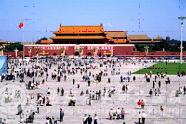 天安门广场是北京的心脏地带,世界上最大的城市广场。西面的人民大会堂,是中华人民共和国全国人民代表大会开会的地方。东面是国家博物馆。南面是人民英雄纪念碑和毛主席纪念堂。天安门广场面积44公顷,东西宽500米,南北长880米,地面全部由经过特殊工艺技术处理的浅色花岗岩条石铺成。每天清晨的升国旗和每天日落时分的降国旗是最庄严的仪式。 天安门广场是北京的心脏地带,世界上最大的城市广场。西面的人民大会堂,是中华人民共和国全国人民代表大会开会的地方。东面是国家博物馆。南面是人民英雄纪念碑和毛主席纪念堂。天安门广场面积44公顷,东西宽500米,南北长880米,地面全部由经过特殊工艺技术处理的浅色花岗岩条石铺成。每天清晨的升国旗和每天日落时分的降国旗是最庄严的仪式。 |
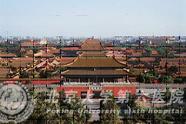 故宫是明、清两朝最大的皇家处理政务和生活起居场所。外廷建筑风格气势宏大、庄严肃穆;内廷类似江南园林,北京四合院,御花园和乾隆花园更是古木森森、山石雄秀、生活气息十分浓厚。 故宫是明、清两朝最大的皇家处理政务和生活起居场所。外廷建筑风格气势宏大、庄严肃穆;内廷类似江南园林,北京四合院,御花园和乾隆花园更是古木森森、山石雄秀、生活气息十分浓厚。 |
|
颐和园 |
天坛 |
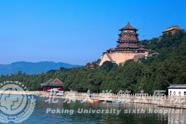 颐和园位于北京的西北郊,原是清代的皇家花园和行宫,主要由万寿山和昆明湖组成,占地290.8公顷,其中水面约占3/4。宫殿、寺庙、园林建筑环绕于山湖之间,其构思巧妙、建筑之精,集中国园林艺术之大成。颐和园是世界上造景丰富、建筑集中、保存最完整的皇家园林。 颐和园位于北京的西北郊,原是清代的皇家花园和行宫,主要由万寿山和昆明湖组成,占地290.8公顷,其中水面约占3/4。宫殿、寺庙、园林建筑环绕于山湖之间,其构思巧妙、建筑之精,集中国园林艺术之大成。颐和园是世界上造景丰富、建筑集中、保存最完整的皇家园林。 |
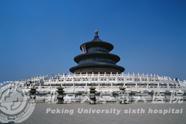 天坛始建于明永乐十八年(1420年),总面积273公顷,经明嘉靖、清乾隆等朝增建、改建,建筑宏伟壮丽,环境庄严肃穆,是明、清两代皇帝"祭天"、"祈谷"的场所,坛域北呈圆形,南为方形,寓意"天圆地方"。坛内主要建筑有祈年殿、皇乾殿、圜丘、皇穹宇、斋宫、无梁殿、长廊等,还有回音壁、三音石、七星石等名胜古迹。天坛集明、清建筑技艺之大成,是中国古建珍品,是世界上最大的祭天建筑群。1998年被联合国教科文组织列入"世界遗产名录"。 天坛始建于明永乐十八年(1420年),总面积273公顷,经明嘉靖、清乾隆等朝增建、改建,建筑宏伟壮丽,环境庄严肃穆,是明、清两代皇帝"祭天"、"祈谷"的场所,坛域北呈圆形,南为方形,寓意"天圆地方"。坛内主要建筑有祈年殿、皇乾殿、圜丘、皇穹宇、斋宫、无梁殿、长廊等,还有回音壁、三音石、七星石等名胜古迹。天坛集明、清建筑技艺之大成,是中国古建珍品,是世界上最大的祭天建筑群。1998年被联合国教科文组织列入"世界遗产名录"。 |
|
八达岭长城 |
明十三陵 |
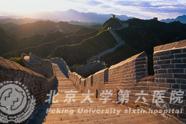 八达岭长城位于北京延庆县南部,在北京城区的西北方向,距市中心75公里。八达岭长城是我国古代伟大的防御工程万里长城的一部分,建于明代弘治十八年(1505年),明嘉靖、万历年间曾加以修葺该段长城地势险峻,居高临下,是明代重要的军事关隘和首都北京的重要屏障。 八达岭长城位于北京延庆县南部,在北京城区的西北方向,距市中心75公里。八达岭长城是我国古代伟大的防御工程万里长城的一部分,建于明代弘治十八年(1505年),明嘉靖、万历年间曾加以修葺该段长城地势险峻,居高临下,是明代重要的军事关隘和首都北京的重要屏障。 |
 明十三陵位于北京城西北约40多公里的昌平区天寿山麓,是明朝十三个皇帝的陵墓所在地,陵区面积达120平方公里,距今已500多年,属国家重点文物保护单位,1992年被认定为世界上保存最完整、埋葬皇帝最多的墓葬群。明十三陵自然环境幽雅,陵寝建筑规模宏大,体系完备,整体性突出,陵寝制度独具风貌,是明朝200余年历史中中国建筑艺术的杰作和陵寝规划与建造的最高代表。而其历史遗存,又从另一个侧面记录了明王朝的盛衰兴亡,记录了明朝文化、艺术、科学技术的发展状况。 明十三陵位于北京城西北约40多公里的昌平区天寿山麓,是明朝十三个皇帝的陵墓所在地,陵区面积达120平方公里,距今已500多年,属国家重点文物保护单位,1992年被认定为世界上保存最完整、埋葬皇帝最多的墓葬群。明十三陵自然环境幽雅,陵寝建筑规模宏大,体系完备,整体性突出,陵寝制度独具风貌,是明朝200余年历史中中国建筑艺术的杰作和陵寝规划与建造的最高代表。而其历史遗存,又从另一个侧面记录了明王朝的盛衰兴亡,记录了明朝文化、艺术、科学技术的发展状况。 |
|
北海公园 |
王府井 |
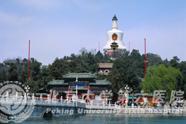 北海公园是国家4A级景区、全国重点文物保护单位。位于市中心,东南面与故宫相邻,有多条公交车可达。原为辽、金、元、明、清五个封建朝代的帝王及皇室成员游幸驻跸、处理政务及祭祀的御用宫室,是现存世界上建园最早、保存最完整的皇城御苑,迄今已有八百余年的历史。北海沿袭中国传统的建筑理念和技艺,具有独特的造园艺术,是我国古典园林的精华和珍贵的文化遗产。占地面积68.2万平方米,其中水面38.9万平方米。北海从规划理念上遵循的是中国传统的“一池三山”的神话传说。 北海公园是国家4A级景区、全国重点文物保护单位。位于市中心,东南面与故宫相邻,有多条公交车可达。原为辽、金、元、明、清五个封建朝代的帝王及皇室成员游幸驻跸、处理政务及祭祀的御用宫室,是现存世界上建园最早、保存最完整的皇城御苑,迄今已有八百余年的历史。北海沿袭中国传统的建筑理念和技艺,具有独特的造园艺术,是我国古典园林的精华和珍贵的文化遗产。占地面积68.2万平方米,其中水面38.9万平方米。北海从规划理念上遵循的是中国传统的“一池三山”的神话传说。 |
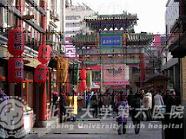 小吃街位于王府井大街好友世界商场的南侧,街的入口处,以一座十余米高的精美的仿古牌楼为门户。街内分四个区域,均以明清建筑风格为基调,却又不拘一格,形态各异。有雕梁画栋、飞檐琉瓦的富贵人家,有小巧玲珑的二层绣楼,也有灰砖土瓦的小门小户。比邻相接、错落有致的街巷,给人们提供了一个游览、观赏的好去处。小吃街集中了北京及各地名优风味小吃,全天经营。尤其是在夜间,整条街红灯高挂,人头攒动。北京和各地的特色小食,如过桥米线、麻辣烫、臭豆腐、狗不理包子,冰糖葫芦等在这里一展风采……还有“梨园”的店小二会邀请游人登上高楼,去喝杯茶,听段儿戏。游人可以感受一下老北京的情调。 小吃街位于王府井大街好友世界商场的南侧,街的入口处,以一座十余米高的精美的仿古牌楼为门户。街内分四个区域,均以明清建筑风格为基调,却又不拘一格,形态各异。有雕梁画栋、飞檐琉瓦的富贵人家,有小巧玲珑的二层绣楼,也有灰砖土瓦的小门小户。比邻相接、错落有致的街巷,给人们提供了一个游览、观赏的好去处。小吃街集中了北京及各地名优风味小吃,全天经营。尤其是在夜间,整条街红灯高挂,人头攒动。北京和各地的特色小食,如过桥米线、麻辣烫、臭豆腐、狗不理包子,冰糖葫芦等在这里一展风采……还有“梨园”的店小二会邀请游人登上高楼,去喝杯茶,听段儿戏。游人可以感受一下老北京的情调。 |
|
胡同 |
国家体育场(鸟巢) |
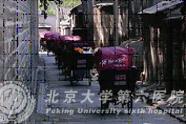 胡同,是北京特有的一种古老的城市小巷。在北京,胡同浩繁有几千条,大部分形成于元、明、清三个朝代。目前,北京的胡同游览线路,主要有南北两条。南线的胡同主要集中在前门附近,以过去明清两代的民居为主,胡同比较狭小。北线集中在什刹海一带,很多过去北京王公贵族的一些大宅门集中在那边。什刹海地区曾经是高官和富贵人家的聚集地,胡同通常比较宽大,随便走过一家不起眼的院门,游客都可以发现昔日的历史踪迹。 胡同,是北京特有的一种古老的城市小巷。在北京,胡同浩繁有几千条,大部分形成于元、明、清三个朝代。目前,北京的胡同游览线路,主要有南北两条。南线的胡同主要集中在前门附近,以过去明清两代的民居为主,胡同比较狭小。北线集中在什刹海一带,很多过去北京王公贵族的一些大宅门集中在那边。什刹海地区曾经是高官和富贵人家的聚集地,胡同通常比较宽大,随便走过一家不起眼的院门,游客都可以发现昔日的历史踪迹。 |
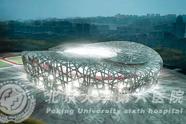 场馆名称:国家体育场(鸟巢) 场馆名称:国家体育场(鸟巢) 地点:奥林匹克公园 场地类型:新建比赛场馆 奥运会期间的用途:开闭幕式、田径、男子足球 残奥会期间的用途:开闭幕式、田径 建筑面积(万M2):25.8 固定座位数:80000个 临时座位数:11000个 赛后功能:将用于国际国内体育比赛和文化、娱乐活动 |
|
国家游泳中心(水立方) |
|
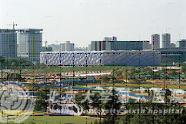 场馆名称:国家游泳中心 (水立方) 场馆名称:国家游泳中心 (水立方) 地点:奥林匹克公园 场地类型:新建比赛场馆 奥运会期间的用途:游泳、跳水、花样游泳 残奥会期间的用途:游泳、跳水、花样游泳 建筑面积(㎡):79532 固定座位数:4000个(永久)、2000个(可拆除) 临时座位数:11000个 |
|
Beijing, the heart of China, is always the first choice of travelers who are willing to know a time-honored and developed city of China. It has been the political, economic and cultural center of China for over 800 years from the Yuan Dynasty. The numerous royal buildings with long history endow Beijing with incomparable charm, not only the 'Nation's Best' but also the 'World's Best'. In addition, as the host city of the 2008 Olympic Games, this oriental historic city presented her best fashion fascination to the world.
There are hundreds of tourist scenic sites in Beijing. Among them, the five major must-see scenic spots in Beijing are the Forbidden City (the Palace Museum), the Temple of Heaven (TianTan), the Summer Palace, the Ming Tombs and the Great Wall. Besides these, ivory carving, jade carving, cloisonne, carpets and other traditional arts and crafts produced in Beijing have world-class reputation.
Climate
Beijing's climate is defined as "continental monsoon." The four seasons are distinctly recognizable. From September to April the following year, dry and cold winter monsoons blow from Siberia and the Mongolian Plateau, resulting in cold and dry winters. From April to September, warm and humid summer monsoons blow from the seas in the east and south, resulting in overall high temperatures and plentiful rainfall.
Autumn is considered to be the best time to visit Beijing as the skies are clear and the weather is very comfortable. The congress holds at the beginning of September, the alternation time from summer to autumn. During the season, there are great temperature difference between morning and night. Mainly, long or short sleeve shirts in the morning and a light jacket or sweater in the evening are the popular clothes. It is recommended to bring a sun hat, umbrella or rain coat.
|
Tiananmen Square |
Forbidden City |
 Located at the center of Beijing City is the Tiananmen Square, where you can visit the Tiananmen Tower, the Monument to the People's Heroes, the Great Hall of the People, the Chairman Mao Memorial Hall and see the national flag-raising ceremony. Thousands of people come to the Square every day. It is the must place to visit in Beijing City. Located at the center of Beijing City is the Tiananmen Square, where you can visit the Tiananmen Tower, the Monument to the People's Heroes, the Great Hall of the People, the Chairman Mao Memorial Hall and see the national flag-raising ceremony. Thousands of people come to the Square every day. It is the must place to visit in Beijing City. |
 The magnificent Forbidden City is the largest and best-preserved imperial palace complex in the world. It has 9,999 rooms in flourishing period with just a single room short of the number that ancient Chinese belief represents 'Divine Perfection' and is surrounded by a six-meter deep moat and ten-meter high wall. For five centuries, this palace functioned as the administrative center of the country. The magnificent Forbidden City is the largest and best-preserved imperial palace complex in the world. It has 9,999 rooms in flourishing period with just a single room short of the number that ancient Chinese belief represents 'Divine Perfection' and is surrounded by a six-meter deep moat and ten-meter high wall. For five centuries, this palace functioned as the administrative center of the country. |
| Summer Palace | Temple of Heaven |
 Situated in the western outskirts of Haidian District, the Summer Palace is 15 kilometers (9.3 miles) from central Beijing. Having the largest royal park and being well preserved, it was designated in 1960 by the State Council as a key cultural relics protection site of China. Containing examples of the ancient arts, it also has graceful landscapes and magnificent constructions. The Summer Palace is the archetypal Chinese garden, and is one of the most noted and classical gardens in the world. Situated in the western outskirts of Haidian District, the Summer Palace is 15 kilometers (9.3 miles) from central Beijing. Having the largest royal park and being well preserved, it was designated in 1960 by the State Council as a key cultural relics protection site of China. Containing examples of the ancient arts, it also has graceful landscapes and magnificent constructions. The Summer Palace is the archetypal Chinese garden, and is one of the most noted and classical gardens in the world. |
 The Temple of Heaven is a worthwhile visiting place in Beijing. It is much bigger than the Forbidden City and smaller than the Summer Palace with an area of about 2,700,000 square meters. The Temple was built in 1420 A.D. during the Ming Dynasty to offer sacrifice to Heaven. As Chinese emperors called themselves 'The Son of Heaven' , they dared not to build their own dwelling, 'Forbidden City', bigger than a dwelling for Heaven. The Temple of Heaven is a worthwhile visiting place in Beijing. It is much bigger than the Forbidden City and smaller than the Summer Palace with an area of about 2,700,000 square meters. The Temple was built in 1420 A.D. during the Ming Dynasty to offer sacrifice to Heaven. As Chinese emperors called themselves 'The Son of Heaven' , they dared not to build their own dwelling, 'Forbidden City', bigger than a dwelling for Heaven. |
| The Badaling Great Wall | The Ming Tombs |
 The Great Wall is a symbol of Chinese civilization, and one of the wonders that the Chinese people have created. Badaling Great Wall, the most representative part, was promoted as a key national cultural relic and protected under the approval of the State Council in 1961. In 1988, it was enlisted in the World Cultural Heritage Directory by UNESCO. On July 7 2007, it gained the worldwide reputation again - it was listed among the New Seven Wonders of the World. The Great Wall is a symbol of Chinese civilization, and one of the wonders that the Chinese people have created. Badaling Great Wall, the most representative part, was promoted as a key national cultural relic and protected under the approval of the State Council in 1961. In 1988, it was enlisted in the World Cultural Heritage Directory by UNESCO. On July 7 2007, it gained the worldwide reputation again - it was listed among the New Seven Wonders of the World. |
 The Ming Tombs lies 50 kilometers northwest from Beijing City - the general name given to the mausoleums of 13 emperors of the Ming Dynasty (1368 - 1644). The mausoleums have been perfectly preserved, as has the necropolis of each of the many emperors. Because of its long history and palatial and integrated architecture, the site has a high cultural and historic value. The thirteen mausoleums have similar layout and arrangement but vary in size as well as in the complexity of their structures. The Ming Tombs lies 50 kilometers northwest from Beijing City - the general name given to the mausoleums of 13 emperors of the Ming Dynasty (1368 - 1644). The mausoleums have been perfectly preserved, as has the necropolis of each of the many emperors. Because of its long history and palatial and integrated architecture, the site has a high cultural and historic value. The thirteen mausoleums have similar layout and arrangement but vary in size as well as in the complexity of their structures. |
| Beihai Park | Wangfujing Shopping Street |
 With the Forbidden City and Jingshan Park to its east, Zhong Nan Hai (Central and South Seas) to its south, Beihai (North Sea) Park is one of the oldest, largest and best-preserved ancient imperial gardens in China and located in the center of Beijing. This ancient garden, with over 1,000 years' history, is not only a classic combination of the grandiosity of the northern gardens and the refinement of the southern gardens in China, but also a perfect integration of magnificent imperial palaces and solemn religious constructions. With the Forbidden City and Jingshan Park to its east, Zhong Nan Hai (Central and South Seas) to its south, Beihai (North Sea) Park is one of the oldest, largest and best-preserved ancient imperial gardens in China and located in the center of Beijing. This ancient garden, with over 1,000 years' history, is not only a classic combination of the grandiosity of the northern gardens and the refinement of the southern gardens in China, but also a perfect integration of magnificent imperial palaces and solemn religious constructions. |
 The historic shopping street of Wangfujing Daije lies to the east of the Forbidden City in Dongcheng district of Beijing. Bounded by the massive Oriental Plaza department store and Beijing Hotel at its southern end, Wangfujing Daije runs north past the Xindongan Plaza department store on the eastern side, St Joseph's Cathedral (one of Beijing's most important churches) and the Donghuamen Night Market and the Foreign Language Bookstore to the west. Wangfujing Daije is now largely pedestrianized and makes for an interesting experience of both modern and ancient Beijing. The historic shopping street of Wangfujing Daije lies to the east of the Forbidden City in Dongcheng district of Beijing. Bounded by the massive Oriental Plaza department store and Beijing Hotel at its southern end, Wangfujing Daije runs north past the Xindongan Plaza department store on the eastern side, St Joseph's Cathedral (one of Beijing's most important churches) and the Donghuamen Night Market and the Foreign Language Bookstore to the west. Wangfujing Daije is now largely pedestrianized and makes for an interesting experience of both modern and ancient Beijing. |
| Hutong | Bird Nest (China National Stadium) |
 People say that the real culture of Beijing is "the culture of hutong" and "the culture of courtyard". How true that is. Often, it is Beijing's winding hutongs that attract tourists from home and abroad rather than the high-rise buildings and large mansions. As the symbol of Beijing City, hutong has its own layout and structure which makes it a wonder in the world. When taking a bird's eye view of Beijing, you will find the combination of hutongs and courtyards just like an orderly chessboard with delicate gardens, fine rockeries, and ancient ruins. Hutongs have witnessed the development of Beijing. Where there is a hutong, there is a story. People say that the real culture of Beijing is "the culture of hutong" and "the culture of courtyard". How true that is. Often, it is Beijing's winding hutongs that attract tourists from home and abroad rather than the high-rise buildings and large mansions. As the symbol of Beijing City, hutong has its own layout and structure which makes it a wonder in the world. When taking a bird's eye view of Beijing, you will find the combination of hutongs and courtyards just like an orderly chessboard with delicate gardens, fine rockeries, and ancient ruins. Hutongs have witnessed the development of Beijing. Where there is a hutong, there is a story. |
 The National Stadium, affectionately known as Bird's Nest, is situated in Olympic Green, Chaoyang District, Beijing. It was designed as the main stadium for the 2008 Beijing Olympic Games. The Olympic events of track and field, football, gavelock, weight throw and discus were held there. Since October 2008, after the Olympics, the National Stadium has been opened as a tourist attraction. Now, it's the center of international or domestic sports competition and recreation activities. The National Stadium, affectionately known as Bird's Nest, is situated in Olympic Green, Chaoyang District, Beijing. It was designed as the main stadium for the 2008 Beijing Olympic Games. The Olympic events of track and field, football, gavelock, weight throw and discus were held there. Since October 2008, after the Olympics, the National Stadium has been opened as a tourist attraction. Now, it's the center of international or domestic sports competition and recreation activities. |
| Water Cube (The National Aquatics Centre) | |
 The National Aquatic Centre, or Water Cube, sets next to Beijing National Stadium in the Olympic Green. The cube-shaped Aquatic Centre is a steel frame covered with a membrane composed of energy-efficient ETFE, a plastic-like material. The design of the Water Cube is based on the patterns of cells and soap bubbles. ETFE pillows create a bubble effect. The bubbles collect solar energy and help heat the swimming pools. The Aquatics Center hosted the swimming, diving and Synchronized Swimming events during the Olympics. The National Aquatic Centre, or Water Cube, sets next to Beijing National Stadium in the Olympic Green. The cube-shaped Aquatic Centre is a steel frame covered with a membrane composed of energy-efficient ETFE, a plastic-like material. The design of the Water Cube is based on the patterns of cells and soap bubbles. ETFE pillows create a bubble effect. The bubbles collect solar energy and help heat the swimming pools. The Aquatics Center hosted the swimming, diving and Synchronized Swimming events during the Olympics. |
|

 English
English
 院内办公OA登录
院内办公OA登录

 北京大学第六医院
北京大学第六医院 海淀院区:北京市海淀区花园北路51号
海淀院区:北京市海淀区花园北路51号

